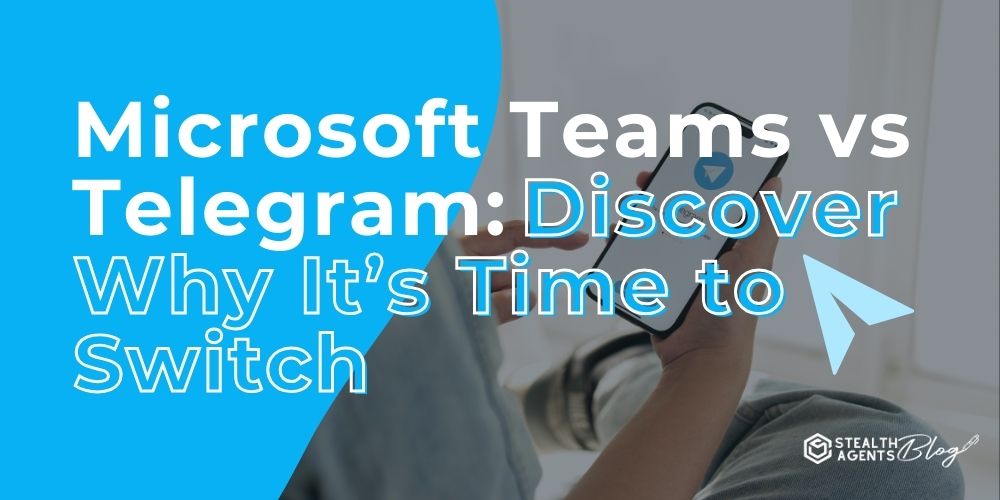Understanding each platform’s unique features is essential when comparing Microsoft Teams vs Telegram.
Microsoft Teams is renowned for its robust virtual assistant services, providing seamless integration into business environments for enhanced collaboration.
It supports team meetings, file sharing, and project management, which makes it a priceless tool for companies looking to increase productivity.
On the other hand, Telegram excels in messaging and community building, offering a user-friendly interface with robust privacy features and the ability to create large group chats.
Depending on the services utilized, Microsoft Teams might have a different cost structure than Telegram’s free services when considering virtual assistant pricing.
Each platform serves distinct purposes, catering to specific communication needs in both professional and casual settings.
Stealth Agents has meticulously created, curated, and compiled this resource to help you make an informed choice tailored to your communication requirements.
What is Microsoft Teams?
Microsoft developed Teams, a feature-rich platform for teamwork intended to improve communication and efficiency in businesses.
It offers seamless integration with Microsoft 365, providing users access to tools for efficient project management and team collaboration.
Teams are perfect for remote and hybrid work settings because they can share files, hold video conferences, and conduct real-time chats.
The platform is tailored for businesses seeking to streamline workflows, allowing employees to collaborate effectively from anywhere.
Microsoft Teams aims to foster a more connected and dynamic workplace by centralizing communication and collaboration tools.
Key Features:
- Integration with Microsoft 365: Microsoft Teams seamlessly integrates with other Microsoft 365 applications, providing a unified workspace that enhances productivity and collaboration across various tools.
- Video Conferencing: The platform supports high-quality video conferencing, allowing teams to conduct meetings, webinars, and interviews quickly and efficiently.
- Chat and Messaging: Teams offer robust chat and messaging features, enabling real-time communication and the instant sharing of files and multimedia content.
- File Sharing and Storage: Integrated with OneDrive and SharePoint, Teams makes file sharing and storage easy and ensures documents are accessible and secure.
- Customizable Workspaces: Users can customize their Teams environments with tabs, apps, and connectors to tailor the platform to specific business needs and workflows.
Pros:
- Enhanced Collaboration: Microsoft Teams significantly improves collaboration by bringing communication, file sharing, and project management into one cohesive platform, reducing the need to switch between applications.
- Security and Compliance: With compliance features and security protocols, Teams ensures that sensitive business information remains protected and meets industry standards for data security.
- Scalability and Flexibility: The system is scalable, supporting organizations of all sizes and accommodating growing teams with its flexible architecture.
- Integration Capabilities: Teams seamlessly integrate with numerous third-party applications, expanding their functionality and allowing businesses to customize their workflows.
- Support and Community: As a Microsoft product, Teams benefit from extensive support resources and a large user community, providing ample learning and troubleshooting opportunities.
Cons:
- Complexity for New Users: The platform’s extensive feature set may be daunting for inexperienced users, requiring a learning curve to fully utilize all of its capabilities.
- Resource-Intensive: Running Microsoft Teams, especially during video calls or with multiple integrations, can be resource-intensive, potentially affecting the performance of lower-end devices.
- Cost Considerations: The comprehensive suite of features may have higher costs than simpler tools, which smaller enterprises may find concerning.
- Dependence on Microsoft Ecosystem: Organizations heavily reliant on non-Microsoft applications might need help integrating these tools within the Teams environment.
- Internet Connectivity: Due to its cloud-based nature, Microsoft Teams can only be used in locations with reliable internet access, which presents a challenge in less connected places.
What is Telegram?
Telegram is a versatile messaging app that provides fast, secure, and reliable communication.
It stands out due to its emphasis on privacy and the ability to support large group chats, catering to individual and professional needs.
With its cloud-based infrastructure, Telegram ensures users can access messages across multiple devices seamlessly.
The app is renowned for its robust security features, which include end-to-end encryption for all types of communication.
Furthermore, Telegram offers a wide range of multimedia-sharing options, making it ideal for those who value comprehensive communication solutions.
Key Features:
- End-to-End Encryption: Telegram offers end-to-end encryption for secret chats, ensuring that messages can only be read by the intended recipient. This feature enhances privacy and protects sensitive information.
- Cloud-Based Messaging: Messages are stored in the cloud, allowing access from multiple devices without data loss. This ensures continuity and convenience for users who switch devices frequently.
- Large Group Chats: Users can create groups with up to 200,000 members, making Telegram ideal for community building and large-scale communication. This feature supports both public and private group settings.
- Multimedia Sharing: Telegram supports a wide array of media types, including photos, videos, and documents up to 2GB. This makes it easy for users to share and collaborate on various content formats.
- Bots and Automation: The platform supports bots that can automate tasks, provide information, and enhance user interaction within chats. These bots can be customized to suit various needs and preferences.
Pros:
- Strong Privacy Controls: Telegram emphasizes user privacy, offering features like secret chats and self-destructing messages. These tools empower users to control their data and communication.
- Fast and Reliable: The app is known for its speed, delivering messages instantly and reliably, even on weak connections. This speed is crucial for maintaining efficient and timely communication.
- User-Friendly Interface: Telegram’s simple, intuitive UI makes it accessible to consumers of all ages because it is straightforward. Its simple layout guarantees that customers can quickly locate and utilize the required functionality.
- Cross-Platform Availability: Telegram is available on various hardware and operating systems, offering a smooth experience across smartphones, tablets, and desktops. This cross-platform support ensures that users can stay connected regardless of their device.
- Extensive Customization Options: Users can tailor their experience with themes, chat backgrounds, and notification settings. This customization allows for a personalized and engaging user experience.
Cons:
- Data Privacy Concerns: Despite its encryption features, Telegram’s default chats are not end-to-end encrypted, which may raise concerns for privacy-focused users. This default setting may not meet the expectations of those seeking complete confidentiality.
- Limited User Base Compared to Competitors: While famous, Telegram’s user base is smaller than that of other major messaging platforms. This limitation can affect the app’s utility for users whose contacts favor other messaging services.
- Complex Features for New Users: Telegram’s advanced features, like bots and channels, may overwhelm new users, and there may be a significant learning curve for individuals unfamiliar with these functionalities.
- Potential for Misuse: The app’s strong encryption and anonymity features can be exploited for nefarious purposes. This potential misuse has led to scrutiny and restrictions in certain regions.
- No Built-In Video Call Feature: Unlike some competitors, Telegram lacks a native video calling feature. This may be a disadvantage for those who would rather integrate video communication. Users have to rely on third-party solutions for video calls.
Microsoft Teams vs Telegram: Detailed Features Comparison
1. Communication Tools
Microsoft Teams is a collaboration tool guideline for effective communication assistance.
Its robust suite, tailored for professional needs, includes video conferencing, VoIP, and threaded conversations.
These features facilitate seamless team interactions, providing a comprehensive platform for meetings and discussions.
In contrast, Telegram focuses on fast and secure messaging with features like end-to-end encrypted secret chats and multimedia sharing.
However, it lacks a native video calling feature, which may disadvantage people looking for integrated communication solutions.
Thus, in the Microsoft Teams vs Telegram debate, Teams offers enterprise users a more complete communication package.
2. Collaboration Features
Microsoft Teams is designed to enhance collaboration with integrated tools such as file sharing, document co-authoring, and project management capabilities.
These features seamlessly connect with other Microsoft 365 applications, boosting productivity for teams working on shared projects.
While Telegram supports large group chats and media sharing, it lacks specialized collaboration tools for virtual assistants to ensure smooth communication, making it more suitable for informal interactions.
The absence of collaborative document editing can be a limitation for professional teams.
Thus, in the Microsoft Teams vs Telegram comparison, Teams offers more comprehensive solutions for collaborative work environments.
3. Security Measures
Security is a significant concern when choosing between Microsoft Teams.
When considering information security, choosing between Microsoft Teams and Telegram is crucial.
Microsoft Teams provides:
- Enterprise-grade security.
- Featuring multi-factor authentication and compliance with data protection regulations.
- It is, therefore, perfect for businesses with stringent security requirements.
Telegram provides end-to-end encryption for private conversations, guaranteeing privacy for sensitive communications, though its default chats lack this encryption, which might concern some users.
Both platforms prioritize security, but Teams delivers more robust solutions for businesses requiring advanced security features, making it a strong contender for an information security virtual assistant.
4. User Interface and Experience
One of the most essential elements of the Microsoft Teams vs Telegram comparison.
Microsoft Teams has a professional and structured interface for users familiar with Microsoft products.
However, its complexity might overwhelm new users, such as small business outsourcing services.
Conversely, Telegram provides an easy-to-use interface that is clear and simple, appealing to users of all ages.
While Teams’ comprehensive feature set caters to a professional audience, Telegram’s simplicity and ease of use make it usable by a larger group of people.
5. Integration Capabilities
In terms of integration, Microsoft Teams shines with its seamless connectivity to Microsoft 365 apps and third-party services, enabling users to streamline workflows and increase productivity.
These integrations are vital for businesses relying on various software solutions, such as top AI customer service software.
Telegram supports bots and automation for enhanced user interaction but needs more depth of integration, as seen in Teams.
For users seeking a platform that integrates smoothly with other enterprise tools, Microsoft Teams offers superior integration capabilities in the Microsoft Teams vs Telegram discussion.
How Stealth Agents Choose Microsoft Teams vs Telegram?
Stealth agents choosing between Microsoft Teams and Telegram must consider several critical factors aligning with their unique operational needs.
Security is paramount, and Microsoft Teams offers enterprise-grade solutions such as multi-factor authentication and compliance with stringent data protection regulations, making it a preferred choice for agents requiring robust security measures.
On the other hand, Telegram provides end-to-end encryption for secret chats, offering a layer of privacy crucial for confidential communications.
However, the lack of default encryption in standard chats might be a drawback.
Regarding communication and collaboration, Microsoft Teams excels with its integrated suite of file-sharing and project management tools, which enhances the productivity of team agents.
Telegram’s simplicity and speed in messaging make it appealing for quick, informal interactions.
Microsoft Teams’ structured user interface may suit agents familiar with complex tools, while Telegram’s ease of use might favor those valuing straightforward and effective communication in different situations.
Ultimately, choosing between Microsoft Teams and Telegram depends on which virtual assistant best meets your specific needs for security, collaboration, and user experience.
Conclusion
In comparing Microsoft Teams vs Telegram, each platform presents unique strengths tailored to different user needs.
Microsoft Teams shines in environments where robust security, comprehensive communication tools, and advanced collaboration features are paramount, making it ideal for businesses and professional teams.
Its structured interface supports users who require detailed organization and seamless integration with other Microsoft products.
Conversely, Telegram excels in providing fast, secure messaging with an intuitive, user-friendly interface, appealing to those who value simplicity and privacy in informal communications.
Ultimately, the choice between Microsoft Teams vs Telegram hinges on specific requirements such as security, ease of use, and the need for professional collaboration, ensuring users select the platform that best aligns with their objectives.












